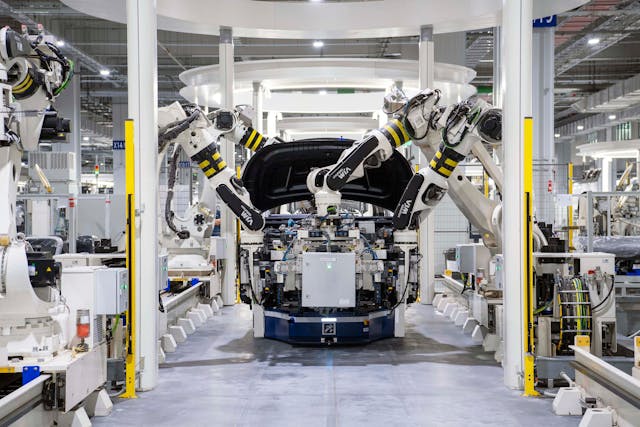In the industrial landscape, ensuring workplace safety is paramount. One of the most innovative solutions that companies are adopting is robotic palletizing. This technology not only enhances operational efficiency but also plays a crucial role in improving safety standards and reducing workplace injuries. In this article, we’ll explore the various ways robotic palletizing systems contribute to a safer work environment and the subsequent reduction in injuries.
The Role of Robotics in Palletizing
Robotic palletizing involves using automated systems to stack products onto pallets, ready for shipping or storage. These systems can vary in design, including articulated robots that mimic human arm movements and gantry robots that operate on a fixed framework. Industries ranging from food and beverage to pharmaceuticals are increasingly turning to these advanced technologies to streamline their operations.
The advantages of robotic palletizing are significant. These systems not only increase efficiency—by working faster and with greater precision than human workers—but they also ensure consistency in how products are handled. With a robotic palletizer, companies can maintain high throughput rates while minimizing errors, ultimately boosting productivity.
Safety Benefits of Robotic Palletizing
One of the most compelling reasons to implement robotic palletizing systems is their profound impact on worker safety. Here’s how they achieve this:
Reducing Physical Strain on Workers
Manual palletizing is physically demanding and can lead to a variety of injuries, particularly musculoskeletal disorders (MSDs). By minimizing the need for heavy lifting and repetitive motions, robotic systems take on these strenuous tasks. Workers can shift their focus to more strategic roles that require problem-solving and decision-making, rather than physically taxing activities.
Mitigating the Risk of Accidents
Robotic palletizers are designed to operate in controlled environments, reducing the likelihood of accidents. The elimination of heavy lifting tasks means that the risk of drops and spills is significantly diminished. Furthermore, advanced sensors and vision systems allow robots to detect obstacles, preventing collisions that could lead to injury.
Enhanced Workplace Ergonomics
The integration of robotic systems allows for improved workplace design. Companies can arrange workspaces to optimize the interaction between humans and machines, enhancing ergonomics. For example, workers can be positioned at comfortable heights and distances from robotic operations, reducing strain and fatigue.
Impact on Workplace Injuries
To fully grasp the significance of robotic palletizing in injury reduction, consider the statistics surrounding workplace injuries related to manual palletizing. Injuries like sprains, fractures, and back problems are common in settings where heavy lifting is routine. The financial burden of these injuries can be substantial, affecting not only employee well-being but also company productivity.
Several companies have documented the positive effects of robotic palletizing on their safety records. For instance, a leading beverage manufacturer reported a 40% decrease in workplace injuries after implementing a palletizing robot system. This reduction was attributed to the decreased physical demands on employees and the elimination of manual handling tasks.
By analyzing before-and-after comparisons of injury rates, it’s clear that robotic systems have a transformative impact. As industries continue to embrace this technology, the overall safety culture within organizations is also likely to improve.
Additional Safety Features of Robotic Systems
Robotic palletizers come equipped with several safety features that further enhance workplace safety.
Most robotic systems are designed in compliance with Occupational Safety and Health Administration (OSHA) regulations and other industry standards. These protocols ensure that the robots are safe to operate and that workers can interact with them without risk.
As robotic systems become more prevalent, the importance of proper training cannot be overstated. Workers need to understand how to interact safely with robotic systems, including knowing when and how to engage emergency stops. Additionally, adapting worker roles to complement robotic systems can lead to a more efficient and safer work environment.
Future Trends in Robotic Palletizing
The landscape of robotic palletizing is continually evolving, with several trends on the horizon that promise to further enhance safety in the workplace.
Technological Advancements
The integration of artificial intelligence (AI) and machine learning into robotic systems is revolutionizing the industry. These advancements allow robots to learn from their environments and improve their operations over time, making them even safer and more efficient. Smart factories, which incorporate Internet of Things (IoT) technologies, will facilitate seamless communication between machines and workers, enhancing safety protocols.
The Growing Importance of Safety in Automation
As more companies recognize the safety benefits of automation, there is a palpable shift in focus towards creating safer work environments. Robotic palletizing is becoming a standard practice, particularly in sectors with high injury rates, as organizations strive to foster a culture of safety and innovation.
Conclusion
Robotic palletizing is not just about efficiency; it’s a critical component of modern workplace safety strategies. By reducing physical strain, mitigating accident risks, and enhancing workplace ergonomics, these systems significantly lower the incidence of workplace injuries. As industries continue to embrace this technology, the potential for improved safety and operational excellence is immense. Organizations looking to invest in a safer future should consider implementing a palletizing robot as a key element of their strategy.
With the ongoing advancements in robotics and a commitment to workplace safety, the future looks promising for both businesses and employees alike. Investing in robotic palletizing is not only a step towards operational efficiency but also a vital move towards creating a safer working environment for everyone.













